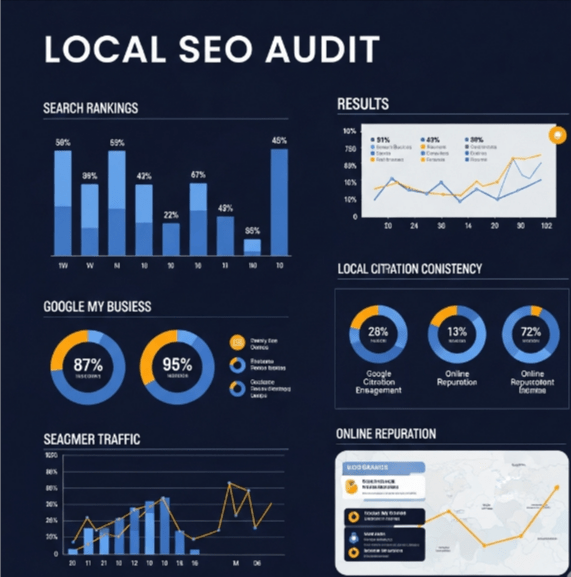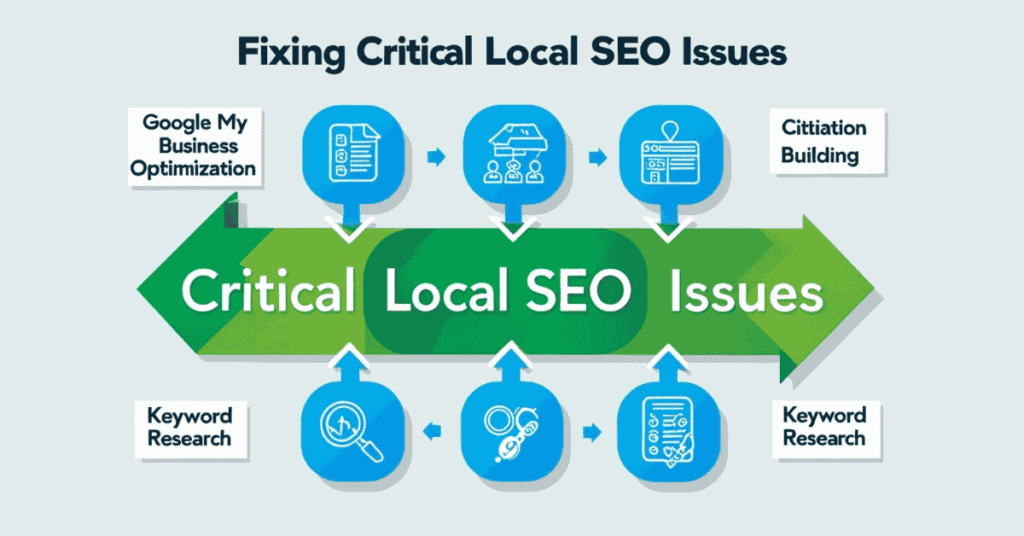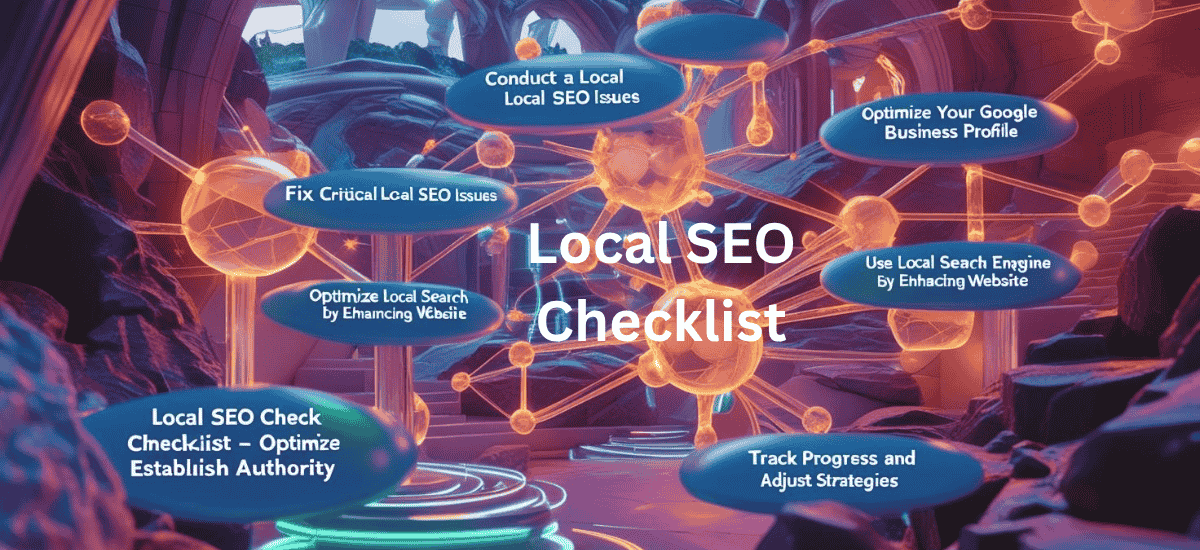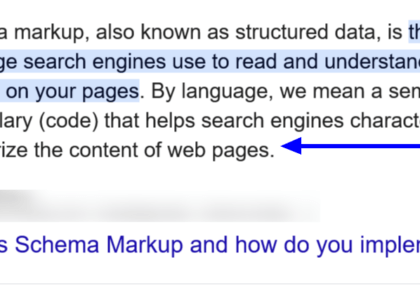Surprisingly, 81% of shoppers look at companies online before making any purchases. A thorough local SEO checklist is therefore essential for companies to find these possible clients.
In the digital age of today, local search engine optimization has grown quite competitive. Google controls about 90% of the search industry; companies that understand local SEO ranking criteria can significantly increase their exposure. Research shows that when consumers receive incorrect information about these companies, they distance themselves from the company. Customer behavior tells a fascinating narrative. Instead of merely looking at Google’s local findings, most prospective customers increasingly look to social media channels for suggestions on nearby companies. To raise their SEO performance on every digital channel, local SEO companies have to follow a methodical approach.
This article presents tried-and-true local SEO strategies with quantifiable outcomes. Running a complete SEO assessment and applying sophisticated optimization strategies helps companies find their full potential in their local market. These steps help them stand out from local competitors and attract more customers.
Conduct a Local SEO Audit
Getting a complete view of your digital presence starts with an effective local SEO plan. Your first audit reveals what needs immediate correction and what is functioning. Let’s discuss four main factors influencing local search.

Check your Google Business Profile setup
GMB profile gives an overview of your main business; it makes a good first impression on your website visitors. Note that GBP plays a significant role in your local search visibility, even more than your website, for local rankings. You have to examine it closely.
First, make sure your profile is verified. Then review these elements:
- Primary and secondary business categories (pick the most fitting categories that match your business)
- Profile completeness (business description, photos, hours of operation)
- Contact information accuracy and consistency with your website
- Response management for reviews and the Q&A section
- Regular post updates and engagement metrics
Businesses receive more visits and driving directions than websites that don’t have good engagement. Your GBP also provides Google with essential information on your company, such as NAP data, opening hours, goods or services, and more.
Audit your website for local SEO basics
Before you modify something, you must first understand what to correct. Seo audit highlights the shortcomings of your website and helps you resolve all kinds of technical and on-page issues. Make sure your website consistently shows your company name, address, and phone number, especially on your homepage and contact page. This data should precisely correspond to that on your Google Business Profile. Companies with several sites should build distinct location pages with location-specific material.
Your website ought to be mobile-friendly, as local searches take place largely on smartphones. Tools such as Morning score provide a total site health assessment with a score and useful advice to address any problems.
Check your NAP consistency and local references
NAP(Name, Address, and Phone number) listing must be consistent across all social media and business listing platforms. For local SEO, search engines rank based on this consistency.
Mixed NAP data confuse users, and search engine Studies reveal that 93% of consumers are annoyed by incorrect web information; 80% of them lose faith in local companies when they discover conflicting contact information.
Here’s how to do a complete citation audit:
- Enumerate every directory featuring your company listing
- Check each listing for NAP consistency
- Document any inconsistencies
- Create a plan to fix all differences
Consistent listings make Google and Bing consider your business authentic. Inconsistencies create digital confusion that hurts rankings.
Analyze your online reviews and ratings
Online reviews help build the trust of your customers; according to research, customers read online reviews before making their purchasing decisions.
Look at these aspects when checking your review profile:
- Average star ratings on all platforms
- Review quantity and frequency (check if it’s gone up or down since the last audit)
- The response rate to good and bad reviews
- Common issues in customer feedback
Research indicates that the more 5-star ratings, the greater the chances of customers converting. Roughly 67% of unfavorable reviewers alter their view following positive owner feedback.
Make a list of your best review websites and examine everyone closely. Fake reviews damage customer trust; therefore, if you come across one, please report it to the relevant authorities.
This total initial audit phase lays a solid basis to carry out smart local SEO changes that produce actual outcomes.
Fix Critical Local SEO Issues
Your local SEO audit uncovers urgent, important problems and fixes all the issues. By correcting their NAP discrepancies, local companies increase their ranking performance by 25%. Any local SEO checklist must include this.

Correct NAP inconsistencies across listings
Google checks whether a company is real using NAP consistency. Small variations might damage your internet presence, such as spelling “Street” in some listings and “St.” in others.
Here is how to correct these discrepancies:
- A master NAP document should be your one source of truth.
- Start with your Google Business Profile, then check other directories.
- Everywhere, keep consistency in your formatting choices (such as “&” or “and”).
- Especially after relocating or changing phone numbers, review your NAP data quarterly.
Studies indicate that incorrect data in internet directories annoys 93% of users. There should be no discrepancies in the NAP (Name, Address, Phone number) listings, as this may confuse your customers. Maintaining consistency in your company information fosters confidence in both consumers and search engines.
Fix website SEO errors affecting local ranking
Technical SEO problems can subtly affect the performance of your local ranking. Your local SEO checklist must address these website issues.
These frequent technical problems call for rapid solutions:
Indexing issues: Look for unintentional NOINDEX meta tags if you notice fewer indexed pages than anticipated. If too many pages appear, search for previous versions or site-hacking spam.
Problems with XML sitemaps: Search engines require these maps in order to crawl your website properly. Outdated or missing sitemaps make it difficult to index your material.
Robots.txt setup— Poor robots.txt configurations can kill natural traffic. If you notice ‘Disallow: /’ in your file, contact your developer immediately.
According to Google’s research website, slow loading leads visitors away from the website. Optimize photos, enhance browser caching, and tidy up JavaScript to help your website load faster.
Dynamic websites and multi-location companies can struggle with duplicate material. Correct duplicate material that confuses search engines by using rel=canonical tags.
Regular site audits enable early detection and correction of technical SEO issues, hence preventing their negative impact on local ranks. Systematic error correction on websites, NAP discrepancy resolution, and cleanup of duplicate listings all contribute to strong local search visibility.
Optimize Your Google Business Profile
You should maximize your Google Business Profile (GBP) after addressing foundation concerns. Data indicates companies with full GBP profiles receive 35% more website clicks and 42% more inquiries for driving directions. Any thorough local SEO checklist must include profile optimization since it is vital.

Choose the right primary and secondary categories
Your local search visibility depends heavily on categories. Your primary category ranks among the most important factors that affect local search rankings. The categories you pick will determine where your business shows up in local searches.
To select categories effectively:
- Define your primary category for your main business
- Include niche-relevant secondary categories
- Be specific with categories (“nail salon” works better than just “salon”)
- Do not use categories just as keywords or descriptors
Seasonal businesses like HVAC companies or landscapers can stay visible year-round by changing their primary category based on seasonal needs. To name just one example, see how switching from “air conditioning repair” to “furnace repair” a few weeks before winter helps maintain visibility.
Add complete business information and photos
A full profile enables you to perform better in local searches. Besides simple NAP (name, address, phone) details, your profile should include:
- Current business hours with holiday schedules
- A detailed business description with relevant keywords
- Features that make your business special (Wi-Fi, outdoor seating, etc.)
- Links to your website and social media
Performance is greatly influenced by photographs. Data from Google indicates that companies with images receive far more client contacts than those without. You ought to add:
- Logo (shown in knowledge panels)
- Main profile image cover photo
- Outside images let consumers locate you.
- Interior photos (display your area)
- Images of products/services (show what you provide)
Photos should be 720px by 720px and range in size from 10KB to 5 MB. Videos should be under 30 seconds long and of at least 720p quality.
Engage with consumers using Q&A and postings
Regular participation through GBP features demonstrates your responsiveness and helps to establish client confidence. New entries tell Google that your business is active.
Advice on efficient posting:
- Inform followers of news, events, or offers
- Include posts with top-notch photos.
- Add obvious calls to action.
- Post on schedule regularly
A good approach to staying ahead of consumer inquiries is the Q&A area. Keep in mind that anyone can respond to inquiries on your profile, which could result in inaccurate information.
Here is how to handle this:
- Include and respond to frequently asked questions yourself
- Respond to fresh inquiries right away.
- Answering honestly and helpfully without pushing
- Report inappropriate or erroneous replies
Active involvement enhances user experience and could help your local SEO by raising interaction. Enable notifications for customer inquiries and reviews. Being responsive like this will help you stand out in crowded local markets.
Optimize Local Search Engine by Enhancing Website
Your local internet presence is built on your website, which requires deliberate optimization. You should increase the local search visibility of your website after addressing basic problems and enhancing your Google Business Profile.
Build landing sites tailored to the locale
For companies operating in several locations, location pages can greatly increase local search prominence. These pages include area-specific data that enables search engines and consumers to grasp your operational zones.
Good location pages require distinct material for every site. To warrant a distinct URL and demonstrate value to search engines, every page should have 40-60% unique material.
The ideal site pages should have the following:
- Staff profiles relevant to that site
- Reviews and comments from customers are site-specific
- Services or stock unique to that site
- Parking information and thorough driving directions
- Local sites or neighborhood ties
- High-quality, location-specific photographs
You should differentiate between geo pages—for service areas without physical presence—and location pages, which are for actual sites. Ranking geo pages is more difficult since establishing geographic relevance without a physical address is difficult.
Use location names to improve meta descriptions and title tags
For local SEO, title tags are among the most powerful ranking elements. They provide search engines and prospective consumers with your page’s material, together with geographical signals.
Local companies should follow the format Keyword | City | Brand Name. This system maintains titles under 50-60 characters and helps search engines know regional significance.
Your meta descriptions should be:
- Unique, comprehensive, and concise to describe the page
- Include naturally occurring location-specific terms
- Include a strong call to action
- Emphasize unusual selling points—luxury service, low cost, and fast response.
Both aspects require geographical terms to flow organically; forced terms could set off spam filters. Remember that these aspects influence click-through rates and ranks; therefore, in search results, they form the first impression of your company.
Use local business schema markup
Local business schema markup is customized coding that helps search engines better grasp your location-specific material. Aimed at small businesses, this organized data uses Schema.org’s consistent language.
Local business schema provides several benefits:
- Improves visibility in local searches
- Optimizes for voice search queries
- Gives search engines precise business information
Your local business schema must include:
- Business name
- Physical address
- Phone number
- Business hours
- Website URL
- Business description
- Company logo
Google suggests using JSON-LD format for schema implementation because it’s “easier to implement and maintain at scale” with fewer errors. The Structured Data Markup Helper from Google can generate this code—pick “Local Businesses,” enter your URL, tag elements correctly, and then download the HTML code.
Use Local SEO Strategies to Establish Authority
Taking intelligent actions that demonstrate to search engines and prospective consumers that are relevant and trustworthy helps your local market authority. Once you have improved your fundamentals, you should concentrate on creating outside signals that increase your authority—a major component of your local SEO to-do list.
Get local backlinks from reliable sources
Local backlinks inform search engines that your company may be trusted, much like digital votes of confidence from other sites. Studies indicate that good backlinks significantly increase page rank and direct search traffic to your site. Local backlink tactics differ from broad link building in that they focus on your community ties.
Valuable local backlink sources include:
- Local news websites and community publications
- Chamber of Commerce and Business Association directories
- Websites of suppliers and vendors (request a backlink in exchange for testimonials)
- Local bloggers and industry influencers
- Local school and educational websites
Quality backlinks from relevant sites pack more punch than many low-quality ones. Create content worth linking to – local guides, community resources, or industry reports that naturally draw links.
Motivate further client feedback
Customer reviews create confidence and influence local search ranks. Research indicates that 85% of people actively seek high star ratings, and 98% of them examine internet reviews for local companies. Furthermore, companies with Google Stars in search results receive up to 80% more clicks.
To receive more evaluations:
- Ask satisfied consumers directly—face-to-face, via email, or on social media.
- Share direct links to your Google review page to make it easy.
- Thoughtfully respond to every review to demonstrate your concern for consumer happiness.
Google prohibits paying for reviews, so please be aware. Rather, use emotive appeals, such as saying how reviews support the expansion of small enterprises.
Engage yourself with regional events and communities
Participating in your community creates ground links that increase your digital power. Local events can improve brand awareness, community website backlinks, and media attention. Sponsoring local sports teams, organizing charity activities, or participating in community festivals helps you produce material deserving of connecting.
Send local media press releases on your community efforts. Add website information, quotations, and images. Later, look for backlinks where you are referenced without a link and examine the internet references of your brand.
This community-first strategy fosters real consumer connections and online authority. Over time, you establish a good cycle that strengthens your local SEO.
Track Progress and Adjust Strategies
Regular monitoring serves as the foundation of a successful local SEO strategy. The real work begins after implementation when you need tracking systems to show what works and areas need improvement.
Monitor local SEO ranking changes
Tracking local ranking fluctuations reveals your optimization initiatives. Local Falcon’s visual map-based tracking reveals the health of your company across Google Business Profiles. Given that around 70% of hits come from the Google Map Pack, this geo-grid approach is useful. Companies that do not show up here stay unseen to possible consumers.
Local RankFlux shows your company ranks in the top 20 search results using weighted ratings for various positions. Moving from rank #2 to #4 is more significant than changing from #19 to #17. Daily scores enable you to identify natural variations as opposed to significant algorithm alterations requiring strategic adjustments.
By using Search Console and Google Analytics, you can get enormous amounts of data about your website
GA4 is an awesome tool that provides data about your website’s performance. These key metrics need attention:
- Landing page performance for organic traffic
- Geographic traffic sources
- User engagement from local searches
- Conversion tracking for calls, forms, and direction requests
The right tracking parameters (UTM tags) for Google Business Profile links help track traffic sources accurately. Looking at 12 months of data instead of 3 months reveals better search patterns.
Google Search Console adds to this information by revealing local search queries that bring visitors to your site. The Performance report shows clicks, impressions, click-through rates, and average position for location-specific keywords. Regular checks of Coverage reports help spot crawling or indexing issues on local pages.
Refine tactics based on performance data
Your strategy needs regular evaluation schedules to work well. Think about setting up:
- Weekly performance checks to spot trends early
- Monthly reviews of key performance indicators
- Quarterly analysis sessions for big-picture strategy updates
Base your strategy changes on metrics that matter – local keyword rankings, GBP engagement rates, and web traffic from local searches. High traffic with low conversions might mean your content needs more local focus.
Watching performance lets you adapt quickly to algorithm changes, seasonal patterns, business updates, and competitor moves. Custom reports that highlight local SEO metrics are the foundations of smart decisions that keep your strategies flexible and effective.
Conclusion
Local SEO mastery demands dedication, smart planning, and consistent execution. This piece explores key steps that can turn average local visibility into exceptional market dominance. Smart businesses that use this detailed local SEO checklist gain an edge over competitors who ignore these significant optimization elements.
Success in local SEO comes from paying attention to details. A strong foundation for local visibility builds on consistent NAP across platforms, really optimized Google Business Profiles, and smart website improvements. Your online reputation directly affects search performance. Businesses that actively gather positive reviews see major improvements in local rankings.
Local SEO is not a “set and forget” strategy. Search algorithms keep evolving, competitors change tactics, and customer behavior changes with time. The most successful local businesses track their progress and adjust strategies based on performance data.





